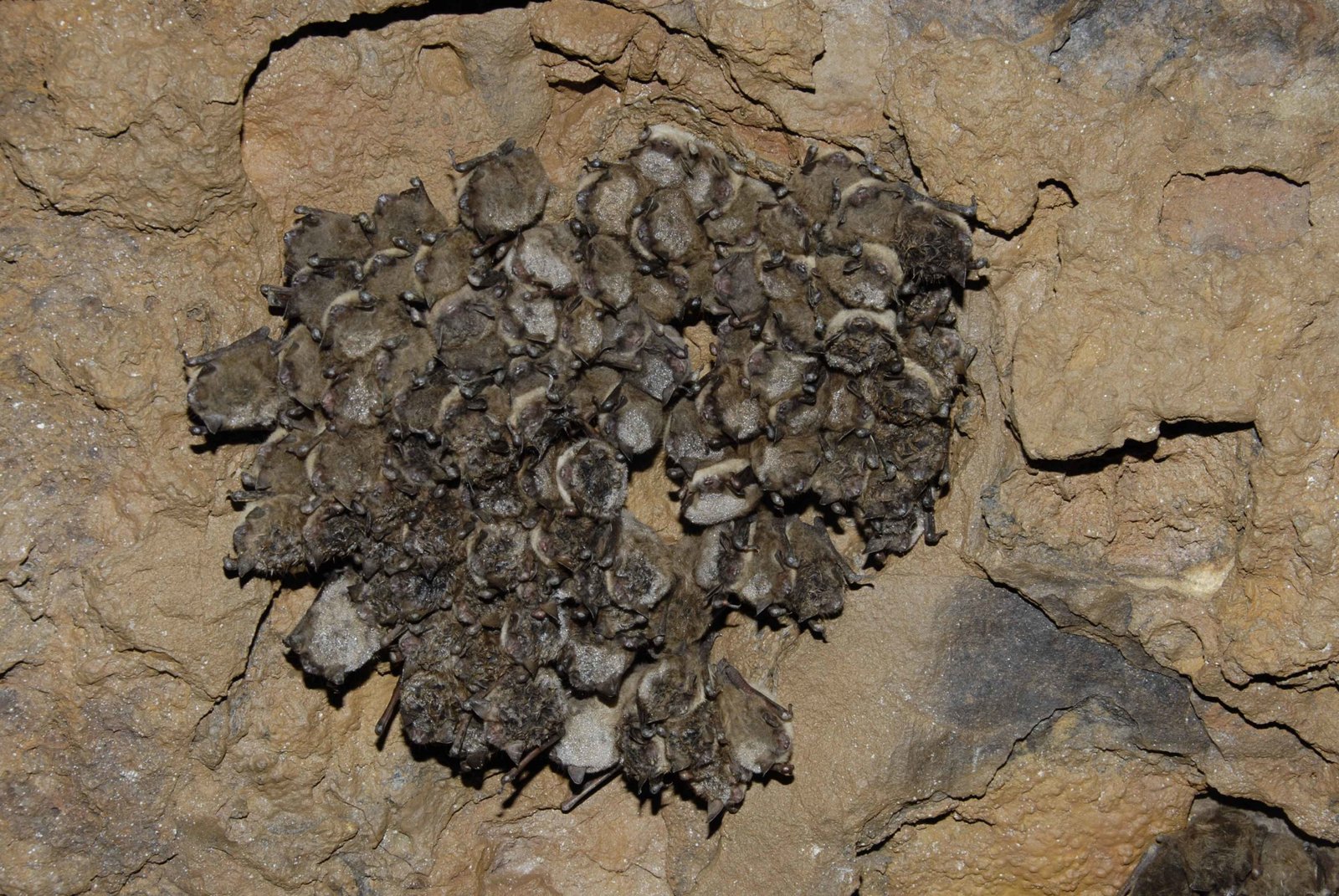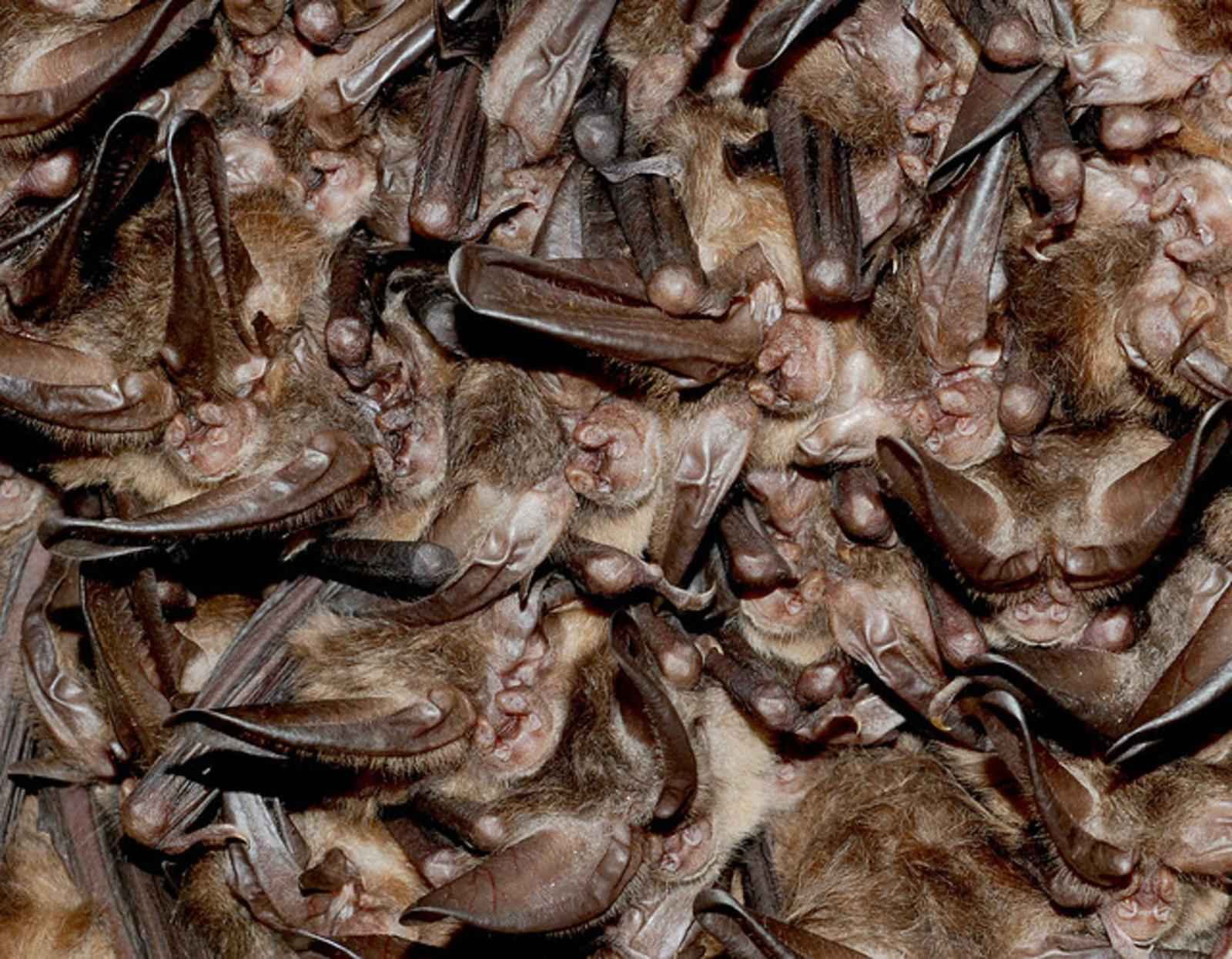Indiana Bat: Myotis Sodalis

Description Of The Indiana Bat Species
The Indiana bat is a smaller mammal, with a length of about 2 inches and weighs approximately .2 -.3 ounces. This species can be difficult to distinguish and is commonly mistaken for the little brown bat (Myotis lucifugus).
The Indiana bat is generally uniformly dark grey to grayish-brown and often has a pink colored nose. The little brown bat ear’s and nose are usually slightly darker, giving the appearance of a dark mask with a slight contrast, a feature that the Indiana bat noticeably lacks.
The feet of Indiana bats are small, roughly 1/3 in length, with little hair. Such hairs do not reach beyond the tips of the toes. In the Indiana bat, the calcar (projection from the foot that supports the foot to the tail membrane) is usually keeled. In tightly packed clusters, Indiana bats are generally found, and only the faces/wrists are noticeable in the center of the cluster. In loose clusters, little browns can be mixed in with the Indiana bat colony. 1Go To Source dec.ny.gov -“Indiana Bat Indiana Bat (Indiana Myotis) Myotis sodalis”
Learn More: Similar Bat Species
Indiana Bat Behavior
Indiana bats are social, which can account for their common alternative name,’ social myotis.’ Within the species, there have been no documented cases of social hierarchies. Males and females hibernate together, but in the summer months, adults separate. There are juvenile males in maternity colonies, but rarely adult males.
Indiana bats migrate seasonally; Indiana bats travel distances of up to thousands of kilometers to move from winter hibernacula to summer roosts.
During the summer months, they have a wide nocturnal foraging range. Perhaps this is why the area of adequate summer habitat for this bat does not correspond to population densities. For example, in a forest of up to 5 million hectares, population estimates are as small as 10,000 bats. It was estimated that another forest area covering 1.7 million hectares had 112,500 Indiana bats. 2Go To Source animaldiversity.org -“Myotis sodalis Indiana bat”
Preferred Habitat Of Indiana Bats

The habitat specifications for the Indiana bat are not fully understood. During the summer, bottomland and floodplain forests were once considered to be the most critical habitats. Still, subsequent research has shown that upland forest habitats, particularly in the southern portions of the range of the species, may-be equally important.
In the southeastern United States, Indiana bats are found in hardwood forests throughout most of their range and mixed hardwood-pine forests.
Typically, Indiana bats spend the winter months in caves or mines. To survive the winter hibernation period, these bats need favorable conditions that will allow them to hibernate for 6 months.
Indiana bats sometimes fly to different hibernaculum areas to find optimal conditions. In search of the most suitable hibernating conditions, Indiana bats may even switch between nearby hibernaculas. In general, Indiana bats are loyal to specific hibernacula they have previously inhibited. 3Go To Source fs.fed.us -“Myotis sodalis”
Indiana Bat Distribution
The Indiana bat lives throughout the eastern United States over the summer months. These bat cluster and hibernate in only a few caves during winter, however.
Every other winter, the largest Indiana bat hibernation sites are surveyed to minimize bat disturbance. Populations since the mid-1980s have increased. However, the Indiana Bat population has declined by 27 percent since first detecting white-nose syndrome in Indiana in 2010.
The Indiana bat only lives in caves during winter; however, few caves provide the necessary hibernation conditions. Low temperatures allow the bats to decrease their metabolic rate and conserve fat reserves. In large, they hibernate in tight clusters that may contain thousands of individuals.
Bats emerge out of hibernation in spring and migrate to summer homes. Because they are divided into smaller social units, little is known about the requirements for summer habitat. During the summer, females form maternity colonies of up to 100 bats. But there were only a few of these colonies found. Colonies have been discovered behind the loose bark of trees, usually near tree-lined streams and rivers.
In midsummer, Indiana bats give birth to only one youngster. In one month, these young bats are capable of flight. The remaining summer/fall months are spent accumulating hibernation fat reserves.
Bats congregate in caves in the fall and begin a period of swarming. During this time, all night long, the bats fly in and out of their cave. However, Mating happens during the swarming period; during hibernation, females store the sperm and do not become pregnant until spring. 4Go To Source in.gov -“Indiana Bats”
Food habits Of Indiana Bats

Indiana bats are insectivores meaning that their diet is based solely on insects. They will migrate to roosting sites with an abundance of bugs and return to the same hunting ground if it’s proven to have insects.
The Indiana bats species use echolocation, which is similar to sonar used in ships, to locate their prey. Echolocation is done by emitting a high-frequency sound that bounces off objects near the bat. The bat will listen to the frequency’s echo and can determine the prey’s size/location. 5Go To Source nwf.org -“Indiana Bat Myotis sodalis”
Indiana Bat’s Top 5 Prey
- Caddisflies
- Flies
- Moths
- Beetles
- Bees
Predators Of The Indiana Bat
This bat species has few predators due to its ability to evade most threats. Roosts are high off the ground (protection from non-flying predation) and can take flight when feeling threatened. Most predators take advantage of a young bat that has fallen out of the roost.
Animals that commonly prey on Indiana bats include raccoons, owls, and snakes.
Threats To The Indiana Bat Species
In 1967, the Indiana bat was listed as endangered because of episodes of people disturbing hibernating bats in caves during the winter, resulting in many bats’ death.
Indiana bats are vulnerable to disruption because they only hibernate in a few caves in large numbers (the largest hibernation caves support from 20,000 to 50,000 bats). Commercialization of caves, loss of summer habitat, pesticides, and other contaminants, the disease white-nose syndrome are other threats that have contributed to the decline of the Indiana bat.
White-nose syndrome (WNS) is a disease that has killed over one million bats since the first observation of dead and dying bats with the distinctive “white-nose” in 2006.
“White-nose” refers to a white fungus ring often seen on the faces and wings of the bats affected. White-nose syndrome, first observed in a cave in New York in February 2006, has spread from New York caves to caves and mines throughout the Northeast, Southeast, and Midwest. 6Go To Source fws.gov -“Indiana Bat (Myotis sodalis)”
References:
- “Indiana Bat – NYS Dept. of Environmental Conservation.” New York State, New York State Department Of Environmental Conservation, www.dec.ny.gov/animals/6972.html. Accessed 7 Jan. 2021.
- Burgess, A. 2012. “Myotis sodalis” (On-line), Animal Diversity Web. Accessed January 07, 2021 at https://animaldiversity.org/accounts/Myotis_sodalis/
- Luensmann, Peggy S. 2005. Myotis sodalis. In: Fire Effects Information System, [Online]. U.S. Department of Agriculture, Forest Service, Rocky Mountain Research Station, Fire Sciences Laboratory (Producer). Available: www.fs.fed.us/database/feis/animals/mammal/myso/all.html [2021, January 7].
- “DNR: Indiana Bat.” Indiana.Gov, Indiana Department Of Natural Resources, www.in.gov/dnr/fishwild/3371.htm. Accessed 7 Jan. 2021.
- The National Wildlife Federation. “Indiana Bat.” National Wildlife Federation, www.nwf.org/Educational-Resources/Wildlife-Guide/Mammals/Bats/Indiana-Bat. Accessed 7 Jan. 2021.
- U.S. Fish And Wildlife Service. “Indiana Bat (Myotis Sodalis).” U.S. Fish and Wildlife Service Midwest Region, 11 Dec. 2019, www.fws.gov/midwest/endangered/mammals/inba/index.html.
